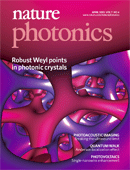Weyl points were first theorized by Hermann Weyl in 1929, who derived the massless solutons to the Dirac equation proposed by Paul Dirac in 1928.
The Weyl equations feature, in the particle dispersion, a three-dimensional linear point degeneracy: the Weyl point.
In 1930, Wolfgang Pauli suggested that Neutrinos satisfy the Weyl equations. This was believed for decades until late 1990s, when the Neutrino mass was observed.
So what indeed does the Weyl equations represent in reality? Do Weyl points exist in nature?
Theoretical prediction of Weyl points in photonic crystals
First public annoucement on 02 July 2012 on arXiv
Published by
Nature Photonics on 27 March 2013
"Weyl points and line nodes in gyroid photonic crystals"
Published as the Journal cover

A commentary by Prof. Jason Fleischer from Princeton University:
"Photonic crystals: Achieving robust Weyl points"
*Gyroids (single and double-gyroids) are minimal surfaces, whose surface energy is locally minimized everywhere. So they self-assemble in butterfly wings, block copolymers, liquid crystals.
Experimental observation of Weyl points
First public annoucement on 11 Feburary 2015 on arXiv
A commentary on the Journal Club for Condesnded Matter Physics, by Prof. Ashwin Vishwanath from University of California, Berkeley.
"Experimental Observation of Weyl Semimetals"
Published by
Science on 16 July, 2015.
"Experimental observation of Weyl points"
Featured on the Journal cover: "Hints of Weyl fermions found in solids"

RESEARCH HIGHLIGHTS:
Topological photonics: Go Weyl'd, by Luke Fleet, Nature Physics 11, 703 (2015)
EDITORIAL:
After a Weyl, Nature Physics 11, 697 (2015)
COMMENTARY:
It's been a Weyl coming, by B. Andrei Bernevig, Nature Physics 11, 698-699 (2015)
RESEARCH HIGHLIGHTS:
Weyl particles discovered Nature 525, 293 (2015)
VIEWPOINT:
Where the Weyl things are, by Ashwin Vishwanath, Physics 8, 84 (2015)

|

|
Fig. 1, gyroid surface with a dime on top.
Image credit: Ling Lu, Qinghui Yan.
|
Fig. 2, Comparison between the experimental and theoretical results. |
|
|
This inversion-breaking double-gyroid sample was made by Andrew Gallant and Ernie Johnson at the
MIT Central Machine Shop.
Weyl points: Wanted for 86 years, by Paola Rebusco
Long-sought phenomenon finally detected, by David Chandler from MIT news
"Discovery of the dream material of 3D graphene" (in Japanese), by Nikkei Technology,
(Chinese version)
Weyl fermions are spotted at long last, by Hamish Johnston from PhysicsWorld.com
Elusive fermion found at long last, by Ida Emilie Steinmark from ChemistryWorld (rsc.org)
"International competition on the discovery of the Weyl particle" (in Chinese), by XiaoXue Chen from Mr. Science
"Discovery of the particle that could revolutionize the entire technology" (in Portuguese), by Inovacao Tech. (Brazil)
"Weyl particle finally observed" (in French), from Futura-Science
Weyl what? Discovery of new particle could lead to low-energy electronics, by Christine Lepisto from TreeHugger.com
Massless particle finally detected from BigNewsNetwork
On the international competition (Chinese) from ThePaper.cn
Also, see
ScienceDaily,
ScienceNews,
ScienceBlog,
Nanowerk News,
Phys.org,
NovusLight,
MaterialsGate,
ChemEurope,
AZoptics,
RDmag,
ScienceCodex,
SciTechDaily,
SciencePart,
ScienceOfWonder,
TechiDec,
2015Tech,
Science20,
Sci-news.





